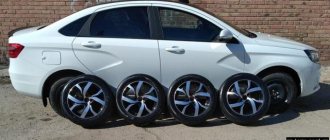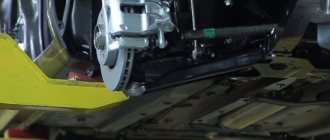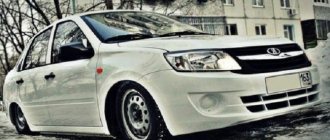Exterior view of Lada Vesta SV Cross
Already in 2021, an unusual domestically produced car appeared on Russian roads. Initially, AvtoVAZ pleasantly surprised the public by releasing the Lada Largus, and now it has offered to purchase the first crossover in its line.
Looking at this car, one immediately notices the increased ground clearance - 203 mm. This will not be enough to conquer wild off-road conditions, but it will be suitable for calmly moving off the asphalt road into rough terrain. And the black plastic body kits are another pleasant visual addition to the increased ground clearance.
Photo source: https://s1.1zoom.me/b5262/882/Lada_Vesta_Cross_Orange_Estate_car_533845_2048x1152.jpg
It is worth noting the powerful enlarged cross-shaped grille, on which a large company nameplate is located; all this is stylishly complemented by chrome inserts. The Lada Vesta SV Cross car and its increased overall dimensions rightfully draw attention to itself from cars of a similar class, such as, for example, the Kia Rio X-Line.
Lada Vesta SV and SW Cross - what is the difference
The success of the Lada Vesta in the market as a whole, and especially in comparison with previous AvtoVAZ models, could not but receive its logical continuation. In 2021, in the fall, Lada Vesta SW and Lada Vesta SW Cross went on sale. Vesta has already managed to make a name for itself, so there was a sense of excitement over the new products, and the start of sales was successful, however, when comparing the SW cross and the regular LadaVesta station wagon, it is not immediately clear why these are different cars at all? In fact, Lada Vesta and Lada Vesta Cross have differences in many parameters, we will try to highlight the main ones.
This is interesting: Hyundai is the desire car of many drivers.
Passport details
Lada Vesta SW 1.8 MTLada Vesta SW Cross 1.8 MTBodyEngineTransmissionChassisPerformance characteristics
| Body type | station wagon | station wagon |
| Number of doors/seats | 5/5 | 5/5 |
| Length, mm | 4410 | 4424 |
| Width, mm | 1764 | 1785 |
| Height, mm | 1512 | 1532 |
| Wheelbase, mm | 2635 | 2635 |
| Front/rear track, mm | 1510/1510 | 1524/1524 |
| Curb weight, kg | 1280–1330 | 1300–1350 |
| Total weight, kg | n.d. | n.d. |
| Trunk volume, l | 480–1344 | 480–1344 |
| Type | petrol | petrol |
| Location | front, transverse | front, transverse |
| Number and arrangement of cylinders | 4, in a row | 4, in a row |
| Number of valves | 16 | 16 |
| Working volume, cm³ | 1774 | 1774 |
| Max. power, hp/rpm | 122/5900 | 122/5900 |
| Max. torque, N•m/rpm | 170/3700 | 170/3700 |
| Transmission | mechanical, five-speed | mechanical, five-speed |
| Drive unit | front | front |
| Front suspension | independent, spring, McPherson | independent, spring, McPherson |
| Rear suspension | semi-independent, spring | semi-independent, spring |
| Front brakes | ventilated disc | ventilated disc |
| Rear brakes | disk | disk |
| Tires | 195/55 R16 | 205/50 R17 |
| Ground clearance, mm | 178 | 203 |
| Maximum speed, km/h | 180 | 180 |
| Acceleration time from 0 to 100 km/h, s | 10,9 | 11,2 |
| Fuel consumption, l/100 km | ||
| — urban cycle | 10,6 | 10,7 |
| - suburban cycle | 6,3 | 6,4 |
| - mixed cycle | 7,8 | 7,9 |
| Toxicity standard | Euro 5 | Euro 5 |
| Fuel tank capacity, l | 55 | 55 |
| Fuel | AI-92-95 | AI-92-95 |
Differences in the design and interior of the cabin
The off-road version of the station wagon looks beautiful and harmonious. The car in the bright orange “Mars” color, also available for the Kalina Cross hatchback, is one of the most interesting cars in the class in terms of design.
Lada SW is lost against the background of the fit and dashing SW Cross. Large wheels (17-inch) of the original design, which the sedan lacked, look great in the off-road version. Owners of a city 5-door car are content with only R15 and R16 wheels.
The main advantage of the all-terrain station wagon is the presence of a decorative black plastic body kit. This is the first thing your eye catches when inspecting a new car. It looks neat and visually enlarges the wheel arches. The decorative and protective body kit gives the SW Cross brutality and aggressiveness, and is designed to preserve the paintwork when driving on light off-road conditions.
At the rear of the off-road version of Vesta there is a decorative trim - a double exhaust pipe. It looks unusual and original.
How do the configurations differ?
AvtoVAZ presented two versions of the Lada Vesta station wagon. Although these two cars are very similar, they have a number of distinctive features. We decided to put the Lada Vesta SW (a simple station wagon) against the “cross”, compare these two modifications and find the main differences.
Lada Vesta SV Cross
If we consider the 1.6 liter model. There is no option to select a gearbox. One configuration is mechanical . Choose a media installation - regular standard or multimedia.
1.8 liter model has a wide selection. Choose between a manual transmission and a robot. These cars are offered in the Prestige . If it is present, the appearance of the interior will change. The rear seats will have armrests. LED lighting will appear in the cabin . The rear window will have a darker tint. The price of the car includes an additional charge for color. For a fashionable one you will have to pay up to 12,000 . That's about how much the Orange Mars design costs.
Lada Vesta SV
The windshield is over the entire surface and the locks are protected from freezing. The car is equipped with a hood deflector . Wear-resistant carpets protect the interior and trunk.
This is interesting: Rating of the best-selling cars based on owner reviews
Comparison of engines and gearboxes of Lada Vesta SV and SV Cross
There is no significant difference in engines and gearboxes between Cross and SV. In total, both models use three engines and two gearboxes. With all sorts of combinations.
Vesta SV received 4 possible options, and Cross SV - only 3. In this case, the manufacturers simply decided to discard the 16-valve 1.6 106 hp. on the robot, but left only AMT with 1.8. See the table below to understand the difference between the Lada Vesta SV and SV Cross in power plants:
| Lada Vesta SW | Lada Vesta SW Cross | |
| 1.6 l 16 cl. (106 hp), 5MT | X | X |
| 1.6 l 16 cl. (106 hp), 5AMT | X | |
| 1.8 l 16 cl. (122 hp), 5MT | X | X |
| 1.8 l 16 cl. (122 hp), 5AMT | X | X |
Transmission
The gearbox in the new Vesta SW is of two types: “robot” and mechanical, and in the crossover with a 1.6 liter engine there will be no “robot”. Let's start with the mechanics. Here we must pay tribute, the reworking of the gears of old models and foreign parts did their job, changing gears is easy and pleasant. But what about the "robot"? Is it really so good that they don’t even put it on a smaller cross-country engine in order to provoke the purchase of a larger one? Rather, on the contrary, the VAZ robot is very far from ideal, it sucks all the pleasure that a manual transmission can provide, our condolences to all those who don’t like it, of course, this is not a detail that should scare you away from the car, but Vest’s mechanics are really nice .
Price difference
Although both cars are station wagons, there are differences in price, and justified ones, so, when we compare the Lada Vesta SW Cross with a more urban version, we find a lot of differences in favor of the first, which, of course, affected the cost.
The base price of Vesta SW is 589,410 rubles, Vesta SW cross is 693,810 rubles. The difference is almost 100,000, for this the unique cross will have: a plastic body kit, “Mars” color, interior trim of the same color, a decorative exhaust pipe nozzle, wider ground clearance, a more advanced suspension and larger wheels, at least an inch. Is it worth 100,000 rubles? You decide. We will just note that in all Vesta AvtoVAZ paid great attention to safety, did not skimp on it, 4 airbags are already included in the most modest configuration, such concern for customers is very pleasant.
Salon
The SW did not receive any major differences from the sedan in terms of interior decoration, but still acquired several pleasant features:
- the space above the heads of rear passengers has increased by 2.5 cm;
- an armrest with cup holders was added to the rear seat;
- A separate button is now used to heat the windshield.
Less significant additions to the interior of the new Vesta are an updated soundtrack for the turn signals and additional color inserts on the door handles and dashboard.
More information about Vesta body dimensions
The standard modification is a sedan. This model has the following body dimensions:
- Vesta's length has grown to 4410 mm, which is akin to a record for a small class;
- the width also makes competitors tremble convulsively, because its value is 1764 mm;
- The wheelbase does not lag behind here, which managed to “stretch” to an impressive 2635 mm;
- the front axle has a track of 1500 mm, and the rear axle is slightly larger - 1510 mm; here the developers initially pursued the goal of bringing the parameters of both tracks to standard values, namely: at the front - 1500 mm, and at the stern - 1490 mm, but it turned out the other way around, which allowed the rear passengers to acquire additional space in the cabin; in general, the body dimensions are really good.
- in terms of weight, the car has become significantly heavier and “gained” 1150 kg (this is without the lack of a full regulated load);
- if the Lada Vesta is fully loaded, the weight will increase to 1670 kg, which is akin to middle-class sedans;
As you can see, in terms of dimensional parameters, the manufacturer did a great job, giving its product the ability to compete in this discipline with cars of a higher class.
dimensions
The main difference between the Cross station wagon and the sedan is the height; for the SV model it is 1532 mm, and this is due to the increased ground clearance. The length of the Vesta SW is 4424 mm, which is 14 mm longer than its younger brother due to the bumper pads. The body width is 1764 mm, the wheelbase and tire track are 1524 mm (remained unchanged). The total weight of the machine is 1280 kg.
You can compare the dimensions of the Lada Vesta SV Cross with another representative of AvtoVAZ - the Lada X-Ray. The latter is much inferior in length, having dimensions of only 4165 mm, but has a height of 1570 mm, which is 38 mm more than the SW.
Vesta SW Cross: dimensional features
The crossover version of the popular Lada Vesta, which appealed to Russian car enthusiasts, appeared in showrooms in September 2016, although the premiere was shown more than a year earlier in August 2015.
Everything would be fine, but Sw Cross turned out to be almost a quarter more expensive than its predecessor. But our task in this review is not to tell you about the devices and options that are why the cross modification has become more expensive, but about the overall dimensions of the Lada Vesta SV Cross station wagon.
| dimensions | |||
| Number of seats | 5 | ||
| Number of doors | 5 | ||
| Length, mm | 4424 | ||
| Width, mm | 1785 | ||
| Height, mm | 1532 | ||
| Wheelbase, mm | 2635 | ||
| Front wheel track, mm | 1524 | ||
| Rear wheel track, mm | 1524 | ||
| Front overhang, mm | 862 | ||
| Rear overhang, mm | 927 | ||
| Trunk volume (min/max), l | n/a | ||
| Ground clearance (clearance), mm | 203 | ||
Related Posts
No Content Available
When starting to implement our task, we point out that:
1. The first thing that catches our brother’s eye when choosing a particular car is the design. With this, in particular, Sw Cross is all right, in other words, it has a quite decent, modern design, very similar to the conceptual model. Here only the sockets and the profile of the fog lights are enlarged compared to the concept;
2. The second is the dimensions of the body . It immediately comes to the mind of the future user that the larger they (body dimensions), the more difficult it is to drive a car in traffic and, most importantly, it is difficult to park;
3. Third – these are the dimensions of the cabin . Everything is clear here, because everyone is trying on the interior, so as not to be like in the children’s song, I don’t want to sit against the wall (meaning the backs of the front seats), as my knees are resting;
4. And fourth – trunk size
Dimensions and capacity of the trunk
Another important difference between the Vesta SW Cross and the sedan is the dimensions and functionality of the trunk. It was equipped with special fastenings and drawers for storing various small items. There are also two removable trays located under a cover in the floor, their size allows you to keep many useful tools and snow brushes there. It is under these containers that the spare wheel with a stamped disk is located.
Photo source: https://www.avtogide.ru/wp-content/uploads/2017/09/4-21.jpg
If you fold the rear seat backs, you can increase the volume of the luggage compartment to 825 liters, while in the standard position the volume from the raised floor to the curtain is 385 liters. The maximum length that can be achieved if you need to transport something long and at the same time close the trunk door is 1820 mm to the back of the front seat, moved forward.
Vesta trunk dimensions
In 2021, AvtoVAZ plans to continue the Vesta line - X-Ray Cross with a liftback body type. The rear overhang of the car will not be vertical, but in the form of a sloping slope, smoothly turning into the trunk. Car owners have already appreciated the advantage of this configuration of the cargo compartment. Folding the seats increases the vehicle's capacity. In normal condition, the trunk volume is 480 liters. If you fold the rear sofas flush with the floor, the compartment increases to 760 liters.
Only in the basic versions of the first generation Lada Vesta did the trunks have a capacity of 250 liters. Starting with the “Comfort” version, the compartment was increased to 480 liters, and in the station wagon – to 500 liters.
Trunk dimensions. Photo source: https://www.drive2.ru/l/488722749137617260/
Comparison with its predecessors: the Granta sedan is 40 liters ahead of the Vesta in terms of trunk volume. The Kalina station wagon lags far behind - 350 hp.
The weight of the Lada Vesta without the regulatory load is 1150 kg. With technical fluids and cargo, the vehicle weight reaches 1670 kg.
Disadvantages of the trunk
And even despite the fact that Vesta SV is the leader in its class in terms of length, several main disadvantages of the luggage compartment can be identified:
- High threshold, making it difficult to load and unload heavy objects. In addition to inconvenience, such a protrusion most often becomes deformed, taking on the blows of oversized loads.
- Insufficient rear door seal. This problem does not occur in everyone and not always, but it still occurs. It appears during intensive washing; water gets into the luggage compartment, since the sealing rubber does not fit tightly to the body.
Of course, the specific owner may not notice these disadvantages, but they are found in the reviews of some drivers.
Trunk dimensions in centimeters Lada Vesta cross version
Trunk measurements in liters are not always clear for understanding the actual dimensions, so they resort to measurements using a tape measure and indicating the values in centimeters. This approach will not leave questions unanswered even for the most inquisitive car enthusiasts. When measuring the luggage compartment of the West Cross with a tape measure, the following values were obtained:
- The depth from the rear row of seats to the plastic trim at the edge is 93 cm.
- The depth from the top of the seats (perpendicular) to the edge of the trunk is 70 cm.
- The depth to the front seats (with the rear row seats folded) is 170 cm.
- The width of the trunk to the wheel arch is 120 cm.
- The width in the wheel arch is 98 cm.
- The opening size is 100 cm.
- The height of the opening is 86 cm.
- The height of the opening from the additional raised floor to the roof of the car (bypassing the curtain) is 70 cm.
In addition to additional niches built into the floor, the cross version of the car also has side niches equipped with nets, hooks and special holding devices for containers with technical fluid.
Cargo capabilities
The presence of guides on the roof involves the installation of roof rails, which will increase the amount of cargo transported. Transporting even such heavy objects as a refrigerator or sofa to the dacha will not create difficulties. High ground clearance, even with a loss of 2-3 cm, will remain suitable for driving in rural areas.
Photo source: https://www.zr.ru/content/articles/908681-ehto-vam-ne-saraj-vzorvet-li/#gal908681-1:0
In addition to everything, you can remove the raised floor cover and the trays hidden under it, increasing the luggage compartment.
Interior dimensions of the domestic model
Thanks to the impressive size of the body, the Lada Vesta managed to acquire a fairly spacious interior. Here, on both seating rows, five people of average build can sit with sufficient comfort. Trips over long distances with such a large number will proceed with comfort and in an unnoticed time.
The developers paid great attention to such an important dimensional parameter as the height inside the LADA Vesta cabin. Thanks to this, Vesta has increased the amount of space between the seat cushions and the roof lining. Tall passengers will feel quite comfortable after boarding. There is also now no risk of catching your head on the edge of the doorway while “immersing” in the cabin.
The length and width of the Russian model had a beneficial effect on the amount of space available for placing the legs of the rear riders. The distance from the back of the front seats to the passenger’s knees in the rear seat row is an enviable 200 mm. Even people 2 m tall will not be able to rest against the front backrests.
The front seat cushions are also comfortable. Their length reaches 45 cm. The rear sofa does not lag behind in this parameter, because the length of its cushion is even greater - as much as 48 cm.
The width of the body allowed three passengers in the stern to fit freely. Accordingly, the length and width of the model were to the taste of buyers.
Specifications
The dimensions and dimensions of the Lada Vesta SV Cross are not the only thing you should pay attention to when choosing this car. AvtoVAZ presented to the public models with both a 1.6 liter engine (with a power of 106 l/s) and a 1.8 l engine (with a power of 122 l/s) on R17 tires.
For the first option, only a manual gearbox is provided, while for a more powerful engine you can choose: manual or robotic. This engine has already been installed on a sedan and has gone through the stage of modifications; all Cross models from 2021 are free of previous shortcomings.
A nice addition for comfort lovers is cruise control and light and rain sensors. The safety system should not be overlooked; it consists of front and side airbags, as well as head restraints in the rear seats.
Of the things that could be replaced on the assembly line, these are frame wipers. For Russia, it is better to use frameless or hybrid structures. And you need to use a windshield wiper suitable for severe frosts so that the liquid in the reservoir does not freeze.
Comparison with competitors
The Lada Vesta, which took first place in sales in 2021, has many rivals. Domestic cars are compared with a number of foreign brands.
Hyundai Solaris
The Korean-designed sedan is assembled on assembly lines in St. Petersburg. Gasoline engine, two types of transmission and ground clearance lower than that of the Lada Vesta - 16 cm.
External dimensions: LxWxH (in mm) – 4405×1729×1470. Trunk volume - 370-480 l - depends on the configuration.
For comparison: the dimensions of the 2021 Lada Vesta station wagon are 4410x1764x1512 mm.
Hyundai Solaris lags behind the sales leader by almost 40 thousand cars per year.
Volkswagen Polo
The Kaluga front-wheel drive competitor is inferior in sales and size to the Lada Vesta sedan. The configurations of the cars are approximately the same.
Polo dimensions:
- D – 4390 mm;
- W – 1699 mm;
- B – 1465 mm.
Trunk volume - 460 l.
Kia Rio
The five-seater family "Korean" - the main rival of the Lada Vesta - is produced in St. Petersburg in sedan and hatchback bodies. Ground clearance in basic models is 160 mm, in the X-Line modification - 195 mm.
External dimensions: 4400x1740x1470 mm.
In terms of the number of cars sold, Kia Rio lags behind Lada Vesta by 5 thousand units.
Lada Granta
Although the cars are the same width, they are not similar in appearance when viewed from the front. "Grant" is 142 mm shorter and 3 mm taller than "Vesta". Ground clearance – 180 mm.
What did the dimensions of the new Lada Vesta influence?
The increased length of the Vesta Station Wagon allows you to feel this not only outside, but also inside. This model is devoid of an important problem that existed in many Lada models; passengers in the rear seats no longer rest their knees on the backs of the front seats.
Photo source: https://www.zr.ru/content/articles/908681-ehto-vam-ne-saraj-vzorvet-li/#gal908681-1:0
Now this is a real family car, as evidenced by the reviews of its owners.
Vesta interior dimensions
External parameters also determine the internal volume of the car - the size of the Lada Vesta's interior. The long, roomy body allows you to transport 5 people of average build.
Trunk of Lada Vesta. Photo source: https://autospot.ru/brands/lada/vesta_sw/wagon/
Main parameters of the salon:
- height from the front (front) seat cushion to the ceiling – from 939 to 990 mm, cushion length – 450 mm;
- height from the rear passenger seat cushion to the ceiling – 896 mm, cushion length – 480 mm;
- the distance from the backs of the front seats to the feet of the rear passengers is 226 mm.
The interior decoration is attractive and ergonomic. The upholstery uses fabric, leatherette (in “Classic” and “Comfort” versions), leather (“Lux”).
Information about engines and oil consumption - in the simplest words
Vesta was supposed to be equipped with three engines. All Vestas are equipped with the Russian 21129 or the new 21279 (2016). The HR16 internal combustion engine from the Renault-Nissan concern with a maximum power of 114 horsepower did not appear. All three engines comply with Euro-5 class, are adapted for winter operation, and can work with several types of transmissions.
21129 - 106 hp engine. With. and a volume of 1.6 liters (1596 cubic centimeters), has 4 pistons arranged in a row. The maximum power is 5800 rpm, which is 78 kW. Maximum torque reaches 4200 rpm. min. This means that the maximum engine power develops at 4000 rpm, then fades out.
21279 - volume 1.8 with 122 horses, in-line, four-piston. This motor is capable of squeezing up to 5900 (90 kW) power revolutions and 3700 torque (170 N m).
Both engines are petrol with electronically controlled fuel injection. Gasoline with a 95 octane rating is recommended for them; Vesta can run at 92. The oil volume in the engines is 4.40 liters. Oil consumption, of course, depends on engine power. The manual Lada Vesta 1.8 “eats” more than the 1.6 liter engine, up to 1 liter per 1000 km. The owners noticed other numbers.
Normally, oil consumption should be 0.3% of the fuel consumed.











